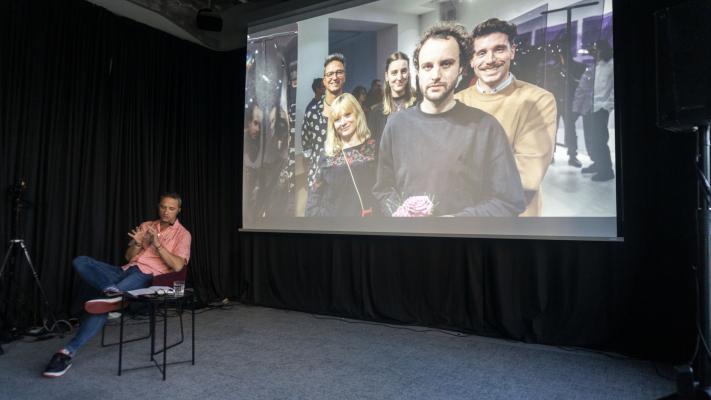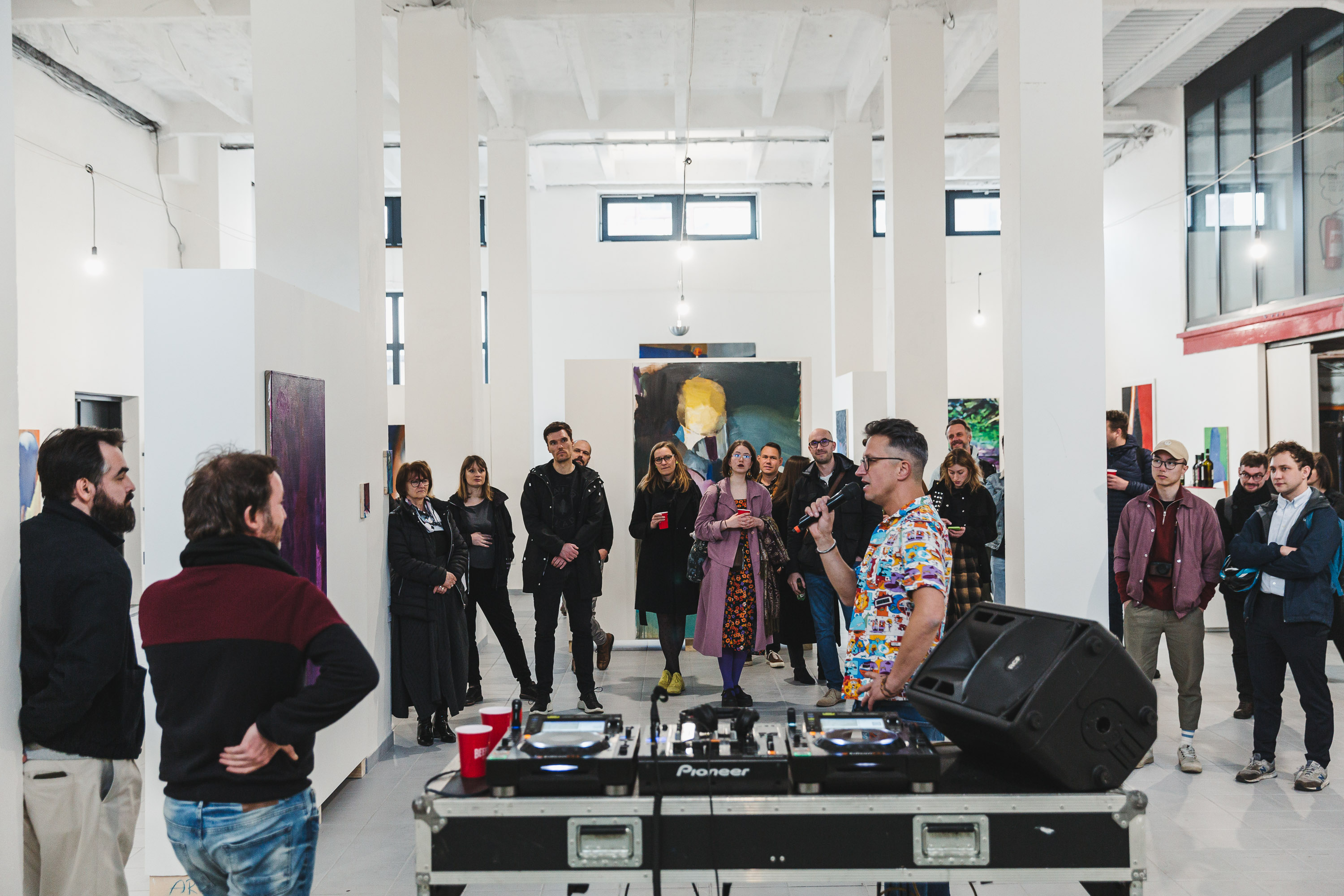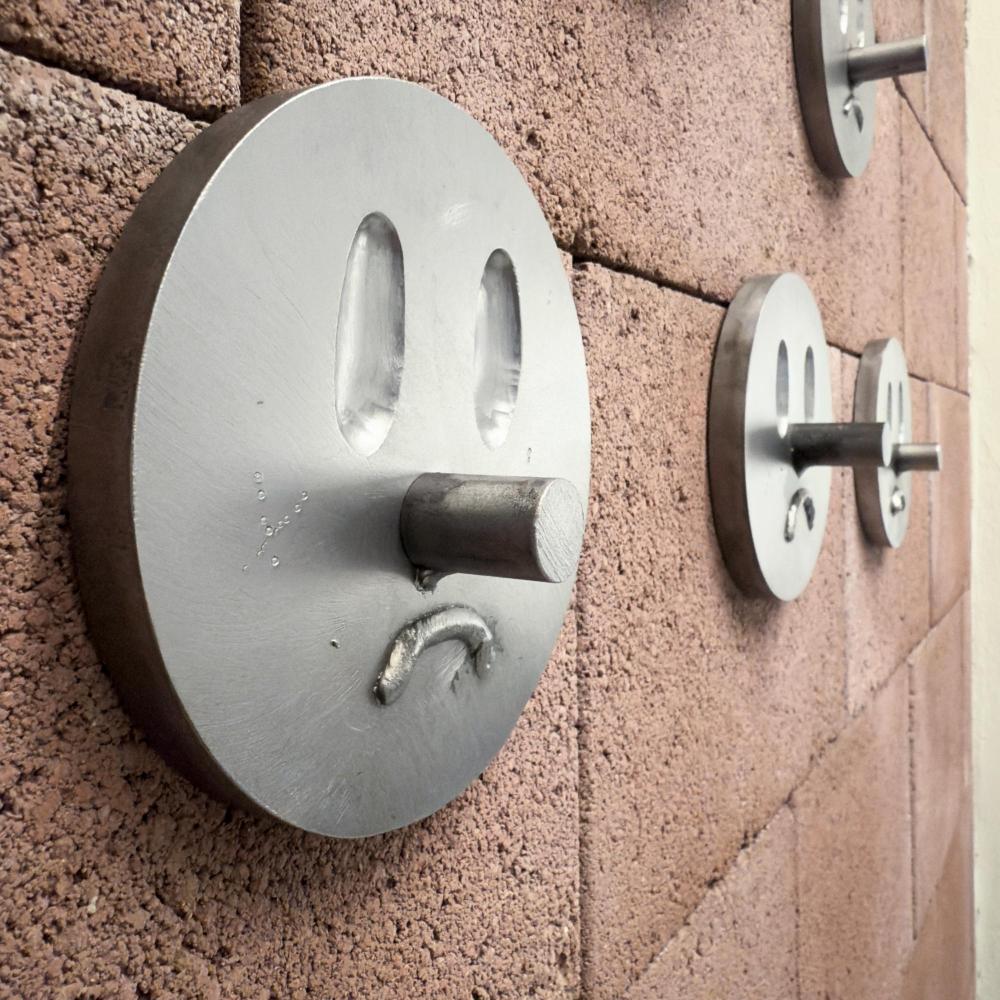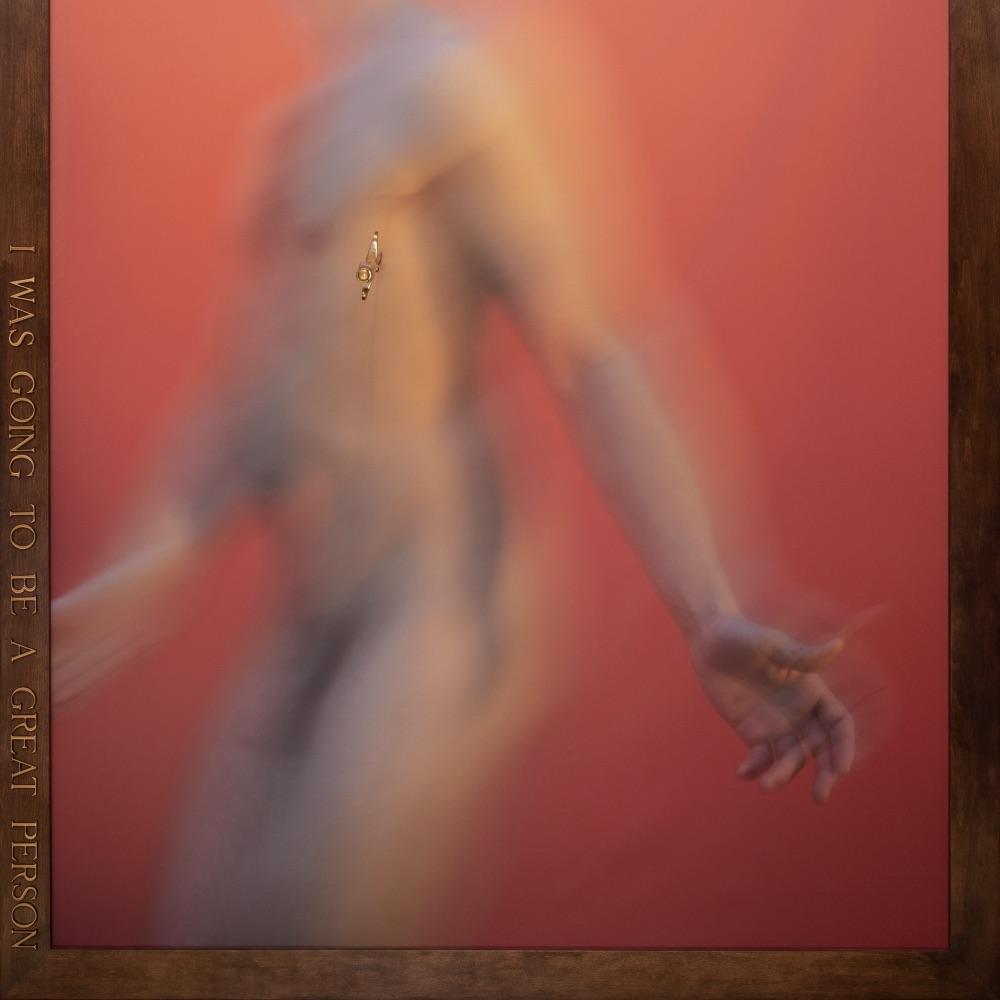
Petr Hájek (*1976) is the artistic director and owner of The Chemistry Gallery. His gallery focuses on the work of young artists, which he exhibits not only in galleries but also at fairs in Europe and the USA. He graduated from the Faculty of Law at Charles University, worked at the Czech Invest agency, the Office of the Government and the international network of consultancies PricewaterhouseCoopers. In addition to the gallery, he runs Chemistry Brothers, an art production company that focuses on creative content creation and the realization of light and multimedia installations.
You didn't study any art, where did your relationship with art come from? Did someone in your family guide you?
I didn't have anyone in my family who was extremely interested in art. And I have to say that for a long time I wasn't very deeply interested in it either. I came up with the idea of starting a gallery when I was leaving one job at the age of thirty, about to start another, and for the first time thinking about what I really wanted to do, what I would enjoy. And I have to say that, in retrospect, it was a surprise to me that I thought of starting a gallery. But suddenly it became an idea that I couldn't get rid of and it was a great idea that I'm very happy to have implemented. So I didn't have any family person to guide me on this path.
The Chemistry Gallery was created in 2008 primarily to give the younger generation of artists a place to showcase their work. Who is involved in the programming and running of the gallery?
I founded the gallery with Martin Kámen, who is a graduate of the Academy of Fine Arts in the studio of Veronika Bromová, a photographer now studying at the Academy of Fine Arts for a PhD under Darina Alster. In the beginning we divided it so that he was in charge of dramaturgy and I was in charge of operation and financing. After a year, Martin left and I managed to immerse myself enough during the first year to determine the dramaturgy myself. I also work with external curators, who I then approach for specific exhibitions. The production work is done by Honza Reindl, whom I originally recruited for external things not too related to the gallery - for example, we did a water projection in an Olomouc park for Robert Runták during his 40th birthday celebration. Honza didn't interfere significantly in the running of the gallery, but that has changed a bit now after the covid, when these external events have stopped and the gallery agenda has grown a lot, but it's more production stuff.
Do you have curators that you work with more often?
Yes, most of my exhibitions have been with Radek Wohlmuth and Petr Vaňous, but I like to expand my curatorial horizons. The last exhibition Reclaimed Temples I did with the curator Jiří Ptáček, who I worked with for the first time, and it was great. But I also had to learn how to be a curator, because at the beginning I didn't know how to do it. What helped me the most was working with Radek Wohlmuth and Michal Pěchouček - Michal curated Tomáš Němec's exhibition, for example - and from them I learned the best how to work with space, and I know that my approach, my perception of space and the layout of the exhibition fifteen years ago was completely different than it is now. Before I was a little bit afraid of it, I didn't know how to approach it, but now I enjoy the curatorial position and I am always curious to see how the artist and I will deal with the challenge of space.
The Chemistry Gallery has moved to different locations over the years, most recently based at Letná. You had to leave this space in the spring and now you are located in Hala 40 at the Holešovice market. Were you hoping to stay longer in Letná, or did you welcome the change?
We had such a not quite secure position in the Letná space. We were subletting there, and I knew that if the landlord wanted the space for his purposes, we would have to leave. I was always in a kind of slight insecurity. It reminded me a little bit of Trafačka when it ended in its original Libeň space. But the moment this situation happened to us, I was not sorry. Finally, the time of uncertainty was over, and at the same time, the impulse of looking for a new place contributed to us finding Hala 40, which is a great place that is much more generous, better and more gallery-like, and I think it took us up a level again. I really liked the space at Letná, but it was small, complicated and broken up. Now we have three hundred square metres, five-metre ceilings and a depository downstairs, which is a huge plus. And I generally take it that if there is a change, it is always a change for the better.

You are close to contemporary electronic music, which you combine with openings. Have you ever returned to the idea of a purely musical space? The spaces of the Holešovice market encourage it.
I don't think of a modern gallery as a sterile white cube space, but as a subject that enters many areas of modern life and should have overlaps into other artistic disciplines such as art, music, videos... That's why, for example, we made a film for the planetarium - we're currently trying to raise money for a second one - and for a while I had a design shop... Music is one of those disciplines that should be related to a modern contemporary art gallery. Two or three times a year I do a music party called Velvet and now we're putting on a big event as part of the Signal Festival. On Thursday, October 12, we will have the opening of the new exhibition Elektrosalon: From the Rave to the Gallery and on Friday, October 13, we will have a Velvet party next door in Hall 17, where we have invited a big name from Berlin, DJ Âme. So in Hall 13 we will have a large-scale installation by the Spanish audiovisual studio Playmodes as part of the Signal Festival, in Hall 40 our Elektrosalon exhibition and in Hall 17 we will have music events on Thursday and Friday. I was thinking at the beginning whether to do music or gallery and I chose gallery, so gradually the music part caught up with me.
As you mentioned, as part of the Signal Festival, you're working with Mark Šilpoch on Elektrosalon: From the Rave to the Gallery, an exhibition about light and club art. What artists will be on show and what makes light art interesting to you?
In 2020 during covid, Mark and I did our first light show. At that time the galleries were closed, but we figured out a way to make the show walkable and attracted a lot of visitors until we needed to book places for a specific date and time. Light installations go very viral. And after this exhibition I said to myself that I would like to do a light installation exhibition at least once a year. Mark went on to do an exhibition with Honza Hladil, then an exhibition with Honza Poša, who does site-specific light installations, and this year it manifested itself in the Elektrosalon exhibition, which will feature light installations by artists who have done light at raves. This is also the basis for the subtitle From the Rave to the Gallery, which was coined by Marek. Marek is an artist who works with light himself, he was previously the curator of the Signal Festival, and the Elektrosalon exhibition is part of his PhD studies at UJEP in Ústí nad Labem, which fulfils the requirement of curating a light exhibition. In addition, the supervisor of his work is Pavel Mrkus, the artistic director of Signal, so everything connects. At the same time, I like the rave environment and I have known the exhibiting artists for a long time, I have been watching and looking forward to what we will create in Hall 40. There will be Czech artists such as Petr Pufler, nicknamed Světlonoš, Honza Slanina, who is a student at the Academy of Fine Arts, Marek Šilpoch, Honza Hladil, Honza Poš and other groups and individuals who often work with light installations at raves and electronic music. It is also a rehearsal of the exhibition, which will be an experience for a small entrance fee. I'm curious to see how many people we can attract.
The Chemistry Gallery appears at art fairs, regularly at Scope in Miami, and this September we saw The Chemistry at Berlin Art Week, where you presented the work of Jiří Marek and Jakub Šveda. How are the sales of Czech artists abroad going?
It's a long run, which requires a lot of money, because participation in these fairs is expensive. At the same time, I think that if Czech private galleries don't go to prestigious fairs abroad, then gradually nobody would be interested in Czech art. And if we want to keep Czech artists in the limelight, both artists and authors have to be active abroad. At first I thought I wanted to conquer New York, then I added Miami, and this year we were in Berlin, where I thought I don't understand why we didn't go there for the first time five years ago. Now I would like to add the German market because it makes sense to present Czech authors there. It was a great experience, the fair was very well organized, although I understood that the Berlin insiders see the festival maybe a little bit through the fingers, because the Berlin galleries that participate were not the main ones. But it's logical, the established galleries already have a name and during Art Week they made their program without having to pay to participate in the fair. But it was all the more interesting for us.
Does The Chemistry Gallery collaborate with other galleries? Alternatively, do you have your own favourite contemporary art institutions?
I think it's important to collaborate with galleries in the Czech Republic, but I feel that the Czech environment is unnecessarily elitist - some people are friends with some people and some people are not. I see every other gallery as a teammate in the same struggle to bring contemporary art to people, and I don't care if a client comes to my gallery and then buys something elsewhere, or vice versa. I like to seek out collaborations and I like to offer them, if it makes sense of course. Last March we did an Art for Ukraine event together with Trafo Gallery, BOLD Gallery and Dox. Last year I organized a mural festival called Wall Street - next year it will be called Urban Pictus - in collaboration with Villa Pellé Gallery, Karpuchina Gallery and BOLD Gallery. And collaboration in relation to foreign countries is something I've now realized in Berlin. On Monday, when Art Week ended, we met the gallerist Gudny Gudmundsdottir, who invited us to her home. She lives right across the street from the Dittrich & Schlechtriem gallery, one of Berlin's top galleries, and she told us that she knows André Schlechtriem, who is a really experienced gallerist, and would find out if he was in the gallery right now. André was at the gallery, so we went to him and talked about fairs in general and he mentioned that he was in New York at The Armory Show and he thinks that the format of fairs is an outdated thing and it doesn't make much sense anymore - also, generally speaking, everyone makes money at fairs except the gallerists who fund everything - so he's not sure if he'll go to any more fairs in the future. He thinks pop-up events are better, which I once thought about too. I was also thinking about cooperating with a foreign gallery, finding a gallery in London, Paris or New York and being on friendly terms with them and having the opportunity to have an exhibition of Czech artists in their country once every few years and vice versa, and using the budget for fairs in that direction. But of course it's a complicated thing why they should do it and vice versa. It's very much about personal contact and a friendly bond.
Now you're going through portfolios sent to your email. How should artists best address you?
I don't rule out getting to an interesting artist that way as well, but my experience is that if someone sends a portfolio via email, I know 90% of the time up front that it probably won't be much, so for me, personal contact is definitely better. That's what happened to me with the painter Petr Hajdyla, who brought a catalogue from his exhibition in Ostrava to the gallery and after looking at it I knew immediately that he was a quality painter and we arranged an exhibition at Dom Radost. It also worked well for me to have someone I trust bring me a portfolio because I know his work and his insight into the art environment, that is, for example, a collector or curator.
What are The Chemistry Gallery's plans and prospects for 2024? Are you staying in the Holešovice Market Hall space?
One ambition is to sell art in the Czech Republic, where I think we are already well placed, because if someone is interested in contemporary art, they will come across us sooner or later. The ambition for the future is to successfully present Czech art abroad, for example through the aforementioned cooperation between galleries. I would like to continue to participate in fairs if it makes sense and if there are the means to do so. We will be doing a small reconstruction in Hall 40 and from January 2024 we will be here permanently, which makes me very happy. I've been pushing back some shows due to moving, so I need to plan the programme properly. But I can reveal the upcoming exhibitions with Jan Rybníček, Alžbeta Josefy, Alena Kocmanová, Jan Uldrych, Tomáš Jetela, Pavel Dušek, Petr Hajdyla and sculptors Josefina Jonášová and Nikola Emma Ryšava.
By Inka Ličková / Telegraph Gallery







